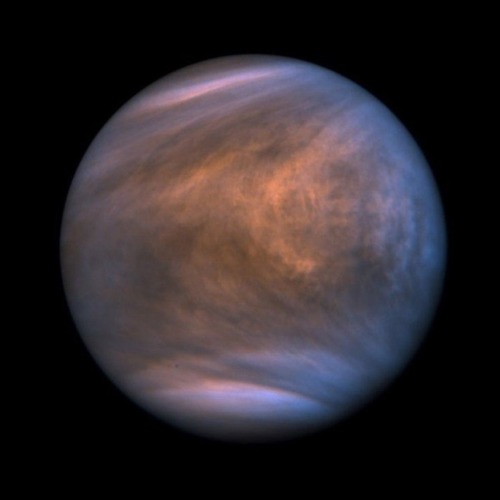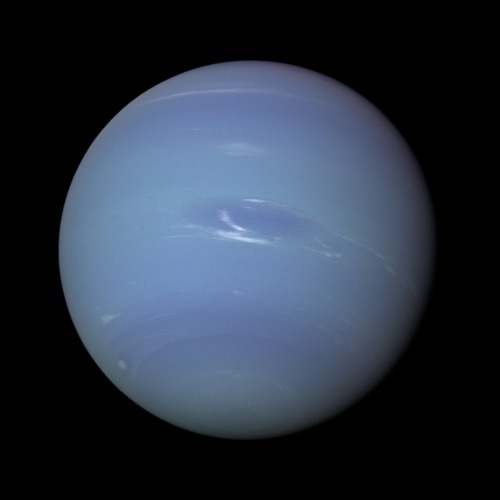Waltzing Dwarfs

Waltzing dwarfs
This seemingly unspectacular series of dots with varying distances between them actually shows the slow waltz of two brown dwarfs. The image is a stack of 12 images made over the course of three years with the Hubble Space Telescope. Using high-precision astrometry, an Italian-led team of astronomers tracked the two components of the system as they moved both across the sky and around each other. The observed system, Luhman 16AB, is only about six light-years away and is the third closest stellar system to Earth — after the triple star system Alpha Centauri and Barnard’s Star. Despite its proximity, Luhman 16AB was only discovered in 2013 by the astronomer Kevin Luhman. The two brown dwarfs that make up the system, Luhman 16A and Luhman 16B, orbit each other at a distance of only three times the distance between the Earth and the Sun, and so these observations are a showcase for Hubble’s precision and high resolution.
Credit: ESA/Hubble & NASA, L. Bedin et al.
More Posts from Starlost and Others
vague post
theres this orb in the sky ive been seeing. i see it every day i dont like it. not naming names


Comet Lovejoy’s long needle-like tail by Fritz Helmut Hemmerich

What is a Rogue Planet?
A rogue planet (also termed a free-floating (FFP), interstellar, nomad, orphan, sunless, starless, unbound or wandering planet) is an interstellar object of planetary-mass, therefore smaller than fusors (stars and brown dwarfs) and without a host planetary system. Such objects have been ejected from the planetary system in which they formed or have never been gravitationally bound to any star or brown dwarf. The Milky Way alone may have billions to trillions of rogue planets, a range the upcoming Nancy Grace Roman Space Telescope will likely be able to narrow down.
Source
image Credit: ESO/L. Calçada/P. Delorme/R. Saito/VVV Consortium
Reading about the Voyager golden record again will heal me
Your fave is problematic: Aliens
first off: I just chose this title so you would read this post… what I really mean is all extraterrestrial life, microscopically small, big, existing and non-existing.
Are we alone?
Right now it is assumed that most stars in our galaxy have at least 1-2 planets. This would mean that there are more planets than stars in our galaxy. With an estimated 100-400 billion stars, you do the math…
Data from the Kepler Space telescope reported in 2013 that there may be about 40 billion planets in their stars’ habitable zone in our galaxy. we also found evidence that there were already first traces of life on Earth shortly after it began cooling. this suggests that it is very easy to start life (as we know it) on a planet, even if it leaves no traces.
So, if life is that easy to create, why don’t we see aliens?
the conditions to create life might be common to exist, but for them to last long enough to create intelligent life…
the field of exoplanets is very young. we have just recently discovered how to properly measure that they exist, and where.
image if you have a street light shining outside and there’s a single mosquito flying around it… kinda hard to spot even if you look closely.
Ok, so other planets are hard to see. But why don’t we hear from aliens through radio waves?
this question is often asked and has several assumptions:
aliens are exactly like us, and have the same senses and shape and form
aliens are currently as evolved as we are and have developed the same technologies
aliens are trying to contact other worlds
these assumptions already give you the answer: the odds are just like, really fucking small. alien life might be entirely, incomprehensibly different. they might have sent signals 40 000 years ago when we were still gathering berries. they might send signals in 400 years when we have nuked each other to death. they might be communicating entirely different. humanity is just really not that advanced and we haven’t been around for very long. especially, we haven’t been listening for very long.
space is VAST. for another civilization to find our radio waves, they could only be 100 light years away and would have to point directly at us. like… imagine.
why haven’t we be visited by aliens?
s.a.: space is VAST. imagine how far a single light year is. visualize. a light year is the distance light travels in a year. light speed is 300,000 kilometers per ONE second. that means that in a year, light travels about 9 trillion kilometres.
my point is that it is impossible to travel at light speed and incomprehensibly difficult to even reach a couple of percent of light speed.
the closest “habitable planet” (tbh, that means shit. a habitable planet might still be a roaring fireball where it rains acid, we don’t fuckin know) is 14 light years away.
the chances of a civilization to find us, want to visit us, have a space ship that supports their form of life for decades, maybe centuries or millennia, they don’t kill each other in that time frame… y’all.
summary: intelligent life and simple life might exist but also might not exist. they might care about us or they might not. they might be so advanced that they are watching us sending rockets to each other countries and bombing each other and were like NOPE. they might be so different from us that we can’t “hear” each other. also watch this video.
overall the situation is fucked or they’re assholes and are like “fuck you”



Venus, Callisto (Jupiter’s moon), Neptune










Planet Earth, April 16, 1972, as seen from the Apollo 16 spacecraft as it journeyed toward the Moon. (NASA)

A cosmic kaleidoscope by Hubble Space Telescope / ESA

Caldwell 103 by NASA Hubble
-
 celeste-tyrrell liked this · 5 years ago
celeste-tyrrell liked this · 5 years ago -
 therandominternetperson liked this · 5 years ago
therandominternetperson liked this · 5 years ago -
 saltythexfilesindianjonescop liked this · 5 years ago
saltythexfilesindianjonescop liked this · 5 years ago -
 pip-bip liked this · 5 years ago
pip-bip liked this · 5 years ago -
 vernacular72-blog liked this · 5 years ago
vernacular72-blog liked this · 5 years ago -
 celestial-perdition liked this · 5 years ago
celestial-perdition liked this · 5 years ago -
 giorgioooo-blog1 liked this · 5 years ago
giorgioooo-blog1 liked this · 5 years ago -
 firebirdtransam68 liked this · 5 years ago
firebirdtransam68 liked this · 5 years ago -
 thedancingfairy liked this · 5 years ago
thedancingfairy liked this · 5 years ago -
 ausevor reblogged this · 5 years ago
ausevor reblogged this · 5 years ago -
 ausevor liked this · 5 years ago
ausevor liked this · 5 years ago -
 smallfryingpan liked this · 5 years ago
smallfryingpan liked this · 5 years ago -
 crystallinewolff reblogged this · 5 years ago
crystallinewolff reblogged this · 5 years ago -
 melodic-aurora liked this · 5 years ago
melodic-aurora liked this · 5 years ago -
 theproblemswiththesky reblogged this · 6 years ago
theproblemswiththesky reblogged this · 6 years ago -
 theproblemswiththesky liked this · 6 years ago
theproblemswiththesky liked this · 6 years ago -
 jeebssred liked this · 6 years ago
jeebssred liked this · 6 years ago -
 darkmeanderings liked this · 6 years ago
darkmeanderings liked this · 6 years ago -
 16fahri liked this · 6 years ago
16fahri liked this · 6 years ago -
 thepizzalovingnerd liked this · 6 years ago
thepizzalovingnerd liked this · 6 years ago -
 michigandrifter liked this · 6 years ago
michigandrifter liked this · 6 years ago -
 mmuehlfeld-blog liked this · 6 years ago
mmuehlfeld-blog liked this · 6 years ago -
 blue---oak liked this · 6 years ago
blue---oak liked this · 6 years ago -
 fagdykefrank liked this · 6 years ago
fagdykefrank liked this · 6 years ago -
 senecasredoubt liked this · 7 years ago
senecasredoubt liked this · 7 years ago -
 hallelujahboys liked this · 7 years ago
hallelujahboys liked this · 7 years ago -
 space-samurai-x reblogged this · 7 years ago
space-samurai-x reblogged this · 7 years ago -
 windydesert reblogged this · 7 years ago
windydesert reblogged this · 7 years ago -
 charleshdv-blog liked this · 7 years ago
charleshdv-blog liked this · 7 years ago -
 ms-mad-scientist reblogged this · 7 years ago
ms-mad-scientist reblogged this · 7 years ago -
 kieliofthemoths-blog reblogged this · 7 years ago
kieliofthemoths-blog reblogged this · 7 years ago -
 kieliofthemoths-blog reblogged this · 7 years ago
kieliofthemoths-blog reblogged this · 7 years ago -
 yoshitsuchi reblogged this · 7 years ago
yoshitsuchi reblogged this · 7 years ago -
 sunshinekara-blog reblogged this · 7 years ago
sunshinekara-blog reblogged this · 7 years ago -
 sunshinekara-blog liked this · 7 years ago
sunshinekara-blog liked this · 7 years ago -
 n1ghtwo1f reblogged this · 7 years ago
n1ghtwo1f reblogged this · 7 years ago -
 n1ghtwo1f liked this · 7 years ago
n1ghtwo1f liked this · 7 years ago -
 singulus liked this · 7 years ago
singulus liked this · 7 years ago -
 akirakkyo1981 reblogged this · 7 years ago
akirakkyo1981 reblogged this · 7 years ago -
 sairyu123 liked this · 7 years ago
sairyu123 liked this · 7 years ago

andrei, he/him, 21, made this at 14 when i was a space nerd but i never fully grew out of that phase so,,,,..,hubble telescope + alien life + exoplanet + sci fi nerd
245 posts
